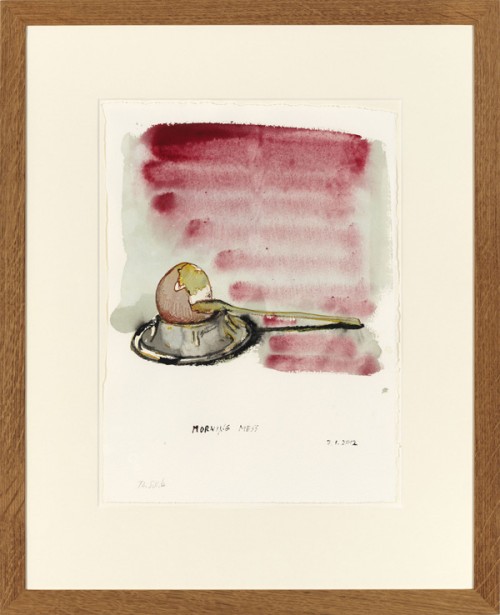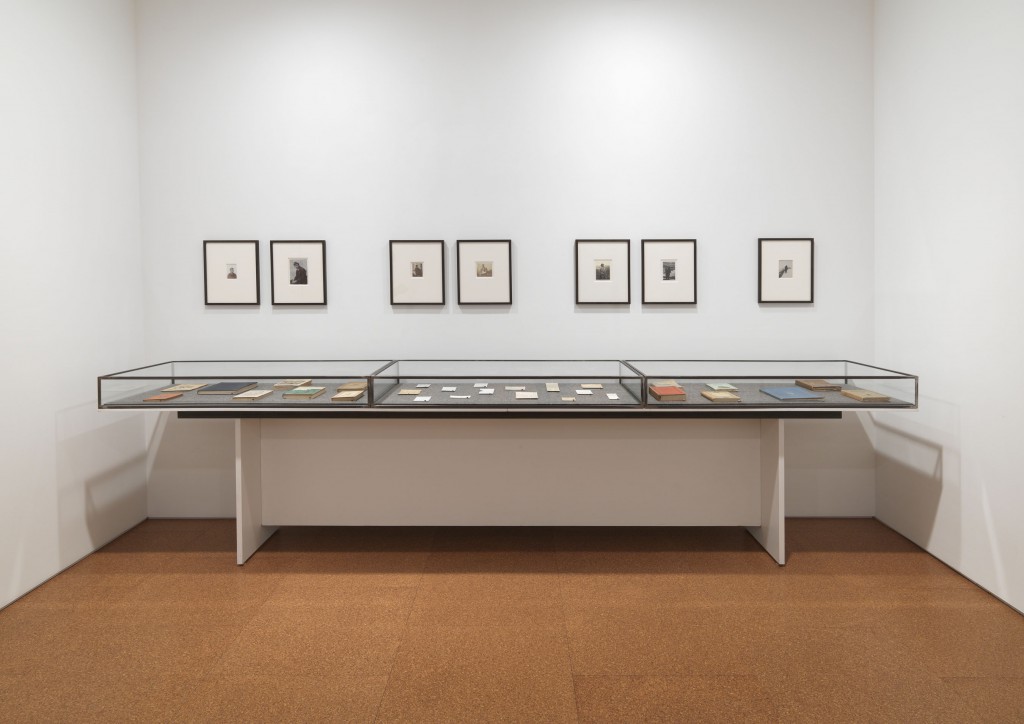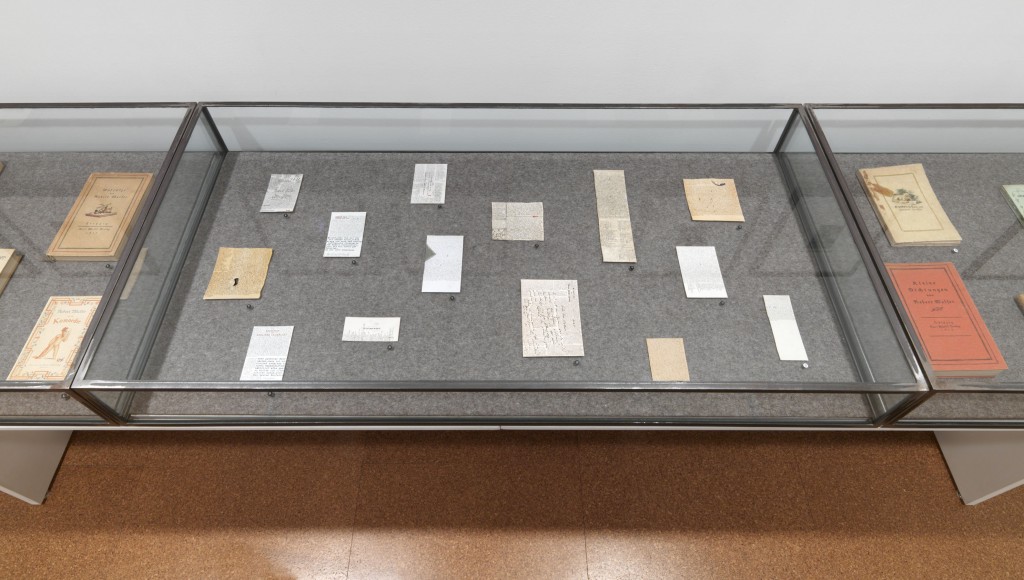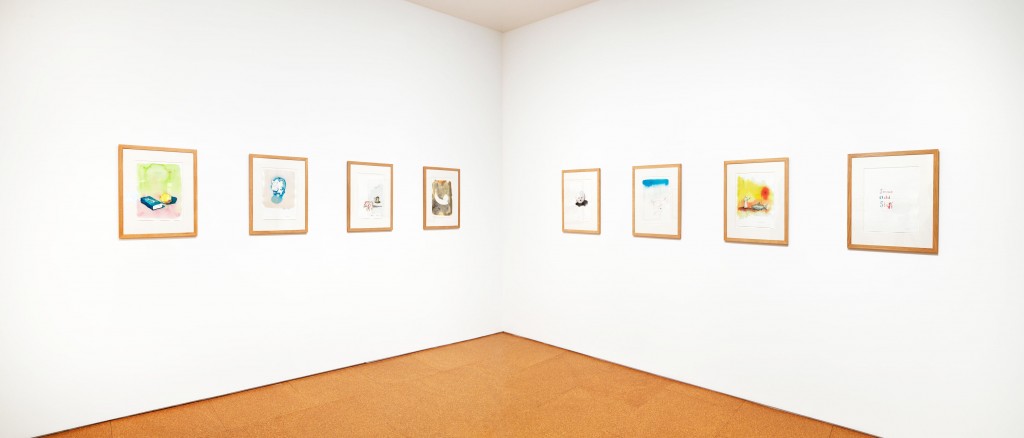If, as I discussed in my previous two guest blog posts, both the artist collaborative Cupola Bobber and MCA guest curator Helen Molesworth are working with the idea of expansiveness, Donald Young Gallery’s In the Spirit of Walser, a series of shows by major contemporary artists in conversation with the nearly-lost writings of Swiss writer Robert Walser, operates on a self-consciously diminuitive scale.
This smallness stems from Walser (1878-1956) himself. An eccentric modernist who notably influenced Kafka, Walser both wrote about modest subjects (he was, according to W.G. Sebald, a “clairvoyant of the small”) and is now most famous for his handwritten miniscule script written on small pieces of paper– nearly illegible writing that at first appears to be encoded. In fact, Walser was simply using a highly miniaturized script in a rare “Kurrent” German style. These notes weren’t discovered until after Walser’s death in 1956, found on everything from the backs of torn envelopes to calendars, receipts, and the covers of novels. The size of the writing may owe much to the fact that Walser had almost no possessions throughout his life– he almost certainly was not buying paper regularly.
Many of these “microscripts,” recently collected and put out in book form last May, are on display at Donald Young in cases along with novels and published work. From a distance, they look like collections of ants crawling on paper surfaces, or pencilled crosshatching for shading effects.
Young himself is fascinated with Walser’s microscripts, which clearly anchor the show. In his curatorial statement Young describes becoming “more and more interested in the connection between his writings and certain contemporary artists, and out of this has come a series of exhibitions…. This is a purely subjective choice and avoids any attempt at an inclusive exhibition or homage to the writer.”
What Young avoids in the show is work by any of the hundreds of artists who have made such personal homages directly to Walser, usually in what Young calls “sentimental form.” Walser is the beau ideal of starving, emotionally unstable, misunderstood radical artists; he never belonged to a literary circle, was at one point institutionalized for a breakdown, and was discovered dead in the snow during one of his frequent long walks. Popular early in his career, Walser was quickly forgotten during his own lifetime. A poet as well as novelist and short story writer, Walser’s stream-of-conscious, swooning writing (he never corrected a sentence, according to admirer Walter Benjamin) is playful and “eludes any kind of systematic treatment,” according to Sebald, his strongest champion. Literary departments quite literally don’t know what to do with him. In thinking about the relationship between visual/plastic arts and writing, Walser’s is a strong case for a kind of writing that would find its most fruitful responses in different riffs from visual art, and not art as call-and-response ode to the writer.
Instead, in early December, Donald Young opened the first of the exhibition series with said archival material and three reinforced clay sculptures of everyday objects (a jug, a shoe, a collection of mushrooms entitled Forest) roughly formed, by Peter Fischli and David Weiss. For Walser, everyday objects get as much (deceptively light) care and attention as his characters who wander through life searching for meaning. Walser’s novel The Apprentice opens:
One morning at eight o’clock a young man stood at the door of a solitary and, it appeared, attractive house. It was raining. “It almost surprises me,” the one standing there thought, “that I’m carrying an umbrella.” In earlier years he had never possessed such a thing. The hand extending down at his side held a brown suitcase, one of the cheapest. Before the eyes of this man who, it seemed, had just comes from a journey, was an enamel sign…
Both these tropes–our relation to inanimate objects in/as human portraits–played out in the two shows following at Donald Young: In January Moyra Davey’s photographed portraits of mysterious people writing on the subway explored the figure of the wandering artist and the character description. This month brings two sculptural busts by Thomas Schütte — one of Walser’s wife, one an “unknown artist” with hands lifted in the gesture of orante in early Christian art– and dozens of Schütte’s new slight watercolor/ pen-and-ink homages to the everyday: a piggy bank, a roll of film, a coconut, a lemon, an egg.

Thomas Schütte. "Morning Mess," 2012. Ink on paper 23 1/2 x 19 3/4 inches, framed. Courtesy Donald Young Gallery, Chicago.
Schütte’s work in particular opens up the possibility of exchange and conversation between Walser’s writing and contemporary art practice; while Schütte began his career with small sculptural figures, he consistently plays with scales of small and large, from these pieces to monumental architectural forms. This scale also gets at the heart of the exhibition and both Walser’s and the modernist writing project at large: to examine the changes in the dimensions of human life in and as our relationship to an increasingly industrialized, and alienating, world.
In the visual arts, where so many artists are also writers and critics (unlike theater, the field in which I began writing criticism, where the conversation between critics and practitioners is usually entirely one-sided), the possibilities for conversations between visual art and different forms of “creative” and critical writing are rich, but many shows fall into a form of tribute to one or the other, or to different types of ekphrasis. Instead, this series of shows gives us one model of how to both anchor and push such conversations.
In March, Donald Young will show work by Rosemarie Trockel, followed by Tacita Dean and Mark Wallinger in April. There will be a related Robert Walser symposium on February 26 at the Goethe Institute.







Pingback: Wandering with Robert Walser » Donald Young